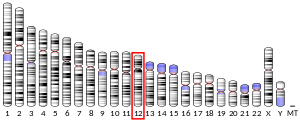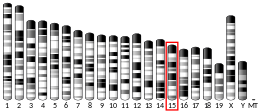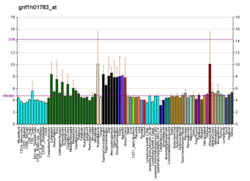AT-rich interactive domain-containing protein 2 (ARID2) is a protein that in humans is encoded by the ARID2 gene.[5]
Function
editARID2 is a subunit of the PBAF chromatin-remodeling complex, which facilitates ligand-dependent transcriptional activation by nuclear receptors.[5]
Structure
editThe ARID2 protein contains two conserved C-terminal C2H2 zinc fingers motifs, a region rich in the amino acid residues proline and glutamine, a RFX (regulatory factor X)-type winged-helix DNA-binding domain, and a conserved N-terminal AT-rich DNA interaction domain—the last domain for which the protein is named.[6]
Clinical significance
editMutation studies have revealed ARID2 to be a significant tumor suppressor in many cancer subtypes. ARID2 mutations are prevalent in hepatocellular carcinoma[7] and melanoma.[8][9] Mutations are present in a smaller but significant fraction in a wide range of other tumors.[10] ARID2 mutations are enriched in hepatitis C virus-associated hepatocellular carcinoma in the US and European patient populations compared with the overall mutation frequency.[6]
References
edit- ^ a b c GRCh38: Ensembl release 89: ENSG00000189079 – Ensembl, May 2017
- ^ a b c GRCm38: Ensembl release 89: ENSMUSG00000033237 – Ensembl, May 2017
- ^ "Human PubMed Reference:". National Center for Biotechnology Information, U.S. National Library of Medicine.
- ^ "Mouse PubMed Reference:". National Center for Biotechnology Information, U.S. National Library of Medicine.
- ^ a b "Entrez Gene: ARID2 AT rich interactive domain 2 (ARID, RFX-like)".
- ^ a b Zhao H, Wang J, Han Y, Huang Z, Ying J, Bi X, Zhao J, Fang Y, Zhou H, Zhou J, Li Z, Zhang Y, Yang X, Yan T, Wang L, Torbenson MS, Cai J (Nov 2011). "ARID2: a new tumor suppressor gene in hepatocellular carcinoma". Oncotarget. 2 (11): 886–91. doi:10.18632/oncotarget.355. PMC 3259997. PMID 22095441.
- ^ Li M, Zhao H, Zhang X, Wood LD, Anders RA, Choti MA, Pawlik TM, Daniel HD, Kannangai R, Offerhaus GJ, Velculescu VE, Wang L, Zhou S, Vogelstein B, Hruban RH, Papadopoulos N, Cai J, Torbenson MS, Kinzler KW (Sep 2011). "Inactivating mutations of the chromatin remodeling gene ARID2 in hepatocellular carcinoma". Nature Genetics. 43 (9): 828–9. doi:10.1038/ng.903. PMC 3163746. PMID 21822264.
- ^ Hodis E, Watson IR, Kryukov GV, Arold ST, Imielinski M, Theurillat JP, Nickerson E, Auclair D, Li L, Place C, Dicara D, Ramos AH, Lawrence MS, Cibulskis K, Sivachenko A, Voet D, Saksena G, Stransky N, Onofrio RC, Winckler W, Ardlie K, Wagle N, Wargo J, Chong K, Morton DL, Stemke-Hale K, Chen G, Noble M, Meyerson M, Ladbury JE, Davies MA, Gershenwald JE, Wagner SN, Hoon DS, Schadendorf D, Lander ES, Gabriel SB, Getz G, Garraway LA, Chin L (Jul 2012). "A landscape of driver mutations in melanoma". Cell. 150 (2): 251–63. doi:10.1016/j.cell.2012.06.024. PMC 3600117. PMID 22817889.
- ^ Krauthammer M, Kong Y, Ha BH, Evans P, Bacchiocchi A, McCusker JP, Cheng E, Davis MJ, Goh G, Choi M, Ariyan S, Narayan D, Dutton-Regester K, Capatana A, Holman EC, Bosenberg M, Sznol M, Kluger HM, Brash DE, Stern DF, Materin MA, Lo RS, Mane S, Ma S, Kidd KK, Hayward NK, Lifton RP, Schlessinger J, Boggon TJ, Halaban R (Sep 2012). "Exome sequencing identifies recurrent somatic RAC1 mutations in melanoma". Nature Genetics. 44 (9): 1006–14. doi:10.1038/ng.2359. PMC 3432702. PMID 22842228.
- ^ Shain AH, Pollack JR (2013). "The spectrum of SWI/SNF mutations, ubiquitous in human cancers". PLOS ONE. 8 (1): e55119. Bibcode:2013PLoSO...855119S. doi:10.1371/journal.pone.0055119. PMC 3552954. PMID 23355908.
Further reading
edit- Martens JA, Winston F (Apr 2003). "Recent advances in understanding chromatin remodeling by Swi/Snf complexes". Current Opinion in Genetics & Development. 13 (2): 136–42. doi:10.1016/S0959-437X(03)00022-4. PMID 12672490.
- Nagase T, Kikuno R, Nakayama M, Hirosawa M, Ohara O (Aug 2000). "Prediction of the coding sequences of unidentified human genes. XVIII. The complete sequences of 100 new cDNA clones from brain which code for large proteins in vitro". DNA Research. 7 (4): 273–81. doi:10.1093/dnares/7.4.271. PMID 10997877.
- Mohrmann L, Langenberg K, Krijgsveld J, Kal AJ, Heck AJ, Verrijzer CP (Apr 2004). "Differential targeting of two distinct SWI/SNF-related Drosophila chromatin-remodeling complexes". Molecular and Cellular Biology. 24 (8): 3077–88. doi:10.1128/MCB.24.8.3077-3088.2004. PMC 381637. PMID 15060132.
- Brandenberger R, Wei H, Zhang S, Lei S, Murage J, Fisk GJ, Li Y, Xu C, Fang R, Guegler K, Rao MS, Mandalam R, Lebkowski J, Stanton LW (Jun 2004). "Transcriptome characterization elucidates signaling networks that control human ES cell growth and differentiation". Nature Biotechnology. 22 (6): 707–16. doi:10.1038/nbt971. PMID 15146197. S2CID 27764390.
- Diederichs S, Bäumer N, Ji P, Metzelder SK, Idos GE, Cauvet T, Wang W, Möller M, Pierschalski S, Gromoll J, Schrader MG, Koeffler HP, Berdel WE, Serve H, Müller-Tidow C (Aug 2004). "Identification of interaction partners and substrates of the cyclin A1-CDK2 complex". The Journal of Biological Chemistry. 279 (32): 33727–41. doi:10.1074/jbc.M401708200. PMID 15159402.
- Patsialou A, Wilsker D, Moran E (2005). "DNA-binding properties of ARID family proteins". Nucleic Acids Research. 33 (1): 66–80. doi:10.1093/nar/gki145. PMC 546134. PMID 15640446.
- Wilsker D, Probst L, Wain HM, Maltais L, Tucker PW, Moran E (Aug 2005). "Nomenclature of the ARID family of DNA-binding proteins". Genomics. 86 (2): 242–51. doi:10.1016/j.ygeno.2005.03.013. PMID 15922553.
- Yan Z, Cui K, Murray DM, Ling C, Xue Y, Gerstein A, Parsons R, Zhao K, Wang W (Jul 2005). "PBAF chromatin-remodeling complex requires a novel specificity subunit, BAF200, to regulate expression of selective interferon-responsive genes". Genes & Development. 19 (14): 1662–7. doi:10.1101/gad.1323805. PMC 1176002. PMID 15985610.
- Zhang X, Azhar G, Zhong Y, Wei JY (Aug 2006). "Zipzap/p200 is a novel zinc finger protein contributing to cardiac gene regulation". Biochemical and Biophysical Research Communications. 346 (3): 794–801. doi:10.1016/j.bbrc.2006.05.211. PMID 16782067.
External links
edit- ARID2+protein,+human at the U.S. National Library of Medicine Medical Subject Headings (MeSH)
- Human ARID2 genome location and ARID2 gene details page in the UCSC Genome Browser.
This article incorporates text from the United States National Library of Medicine, which is in the public domain.





